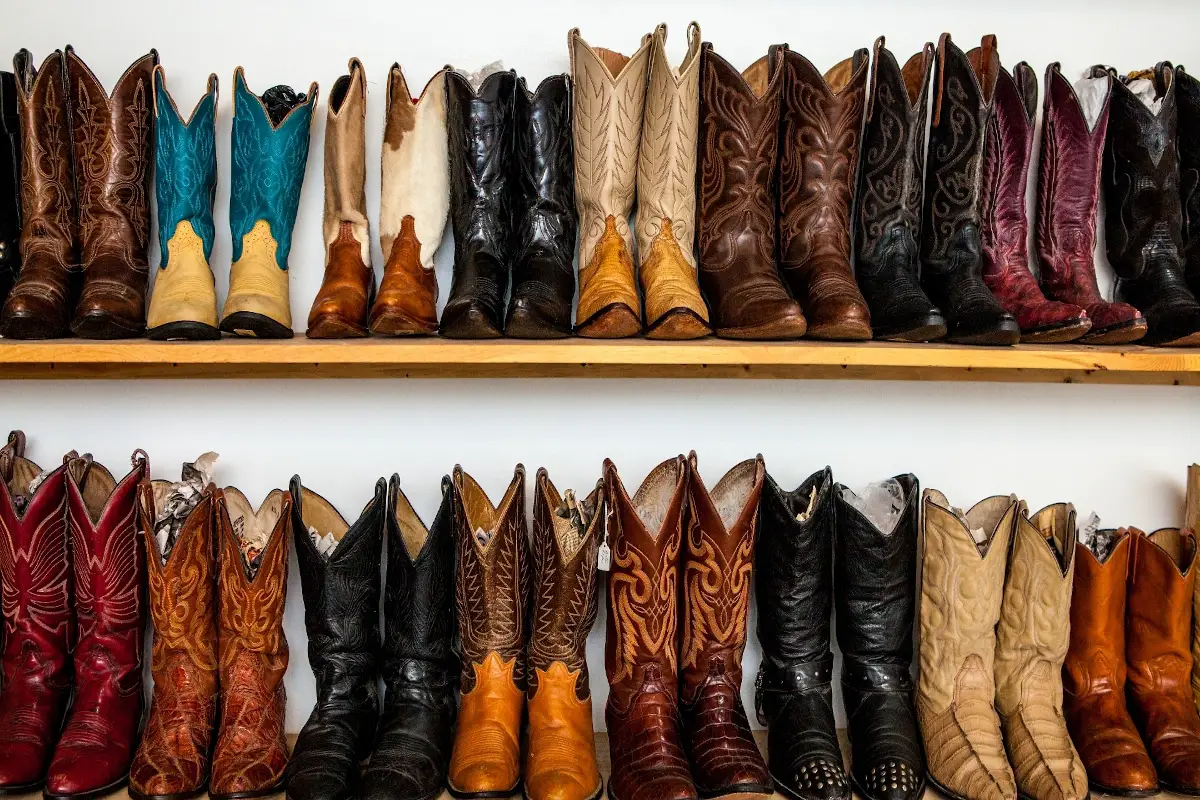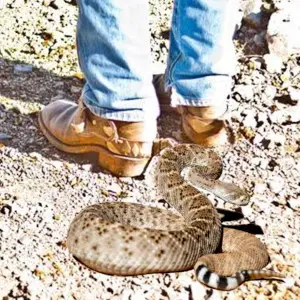Leather is a common material used in boots worn outdoors. However, they may not necessarily protect the wearer from rattlesnake bites. This depends on several factors.
Leather Boots Give You Some Snake Bite Protection
Leather boots, work boots or cowboy boots that are not specifically designed to be snake proof are not guaranteed to stop a rattlesnake from biting through to the skin. They will, however, give you significant protection and reduce the penetraton of the fangs. This gives you a fighting chance to get away and lessens the amount of venom that might be injected at the bite point.
If a rattlesnake gives a glancing bite to the side of the boot it may bounce off or not penetrate the leather cleanly. But you can never bet on this happening, so it’s best to play it safe and wear snake boots in rattler country.
The PSI of a Rattlensake Bite
PSI (pounds per square inch) of a rattlesnake bite is 120-150 depending on the size of the snake.
That kind of a bite will go through nearly all types of leather boots unless they are very thick cowhide or snake-proof. When the leather is very thick and strong, it provides extra protection — much more so than leather sneakers or hiking boots.
Believe it or not, a large rattlesnake does not have the strongest bite force. This title belongs to the larger species of anaconda.

Large Rattlers Have Larger Fangs
Rattlesnake fang length is largely dependent on the snake’s overall size.
Larger rattlers can have fangs up to 1 inch in length, more than long enough to reach the skin under a leather boot. Smaller rattlers also have fangs long enough, being 1/2 to 2/3 of an inch in length.
So, leather boots will protect you from small rattlers, but probably not large ones. Casual or formal soft leather boots will likely not stand a chance against a rattler of any size. Cowboy boots are the most secure against small snake bites due to their overall thickness and durability. However, the only way to keep from being hurt when bitten is to simply stay away from rattlers altogether.
The venom of rattlesnakes is highly toxic and can send anyone to the emergency room and suffer long-term effects from being bitten. When far out in the brush and trails, reaching medical attention before getting seriously ill can be difficult.
A Steel Toe Can Protect…The Toe
A steel toe can definitely stop a rattlesnake bite, but this only protects the toe. This is definitely a bonus to your safety, but again, leaves the rest of your foot and ankle without extra protection. Steel toes are mainly included to protect your toes from falling debris or being jammed into hard surfaces while working outdoors or on construction sites.
Leather Boot Soles
Leather work boots or cowboy boots with thick rubber or hard leather soles can stop a rattlesnake bite from penetrating the bottom of the foot. But being bitten on the sole is not as common as bites to the ankle or top of the foot (also called the vamp, or metatarsal region). And a thin leather sole on a cowboy boot may not stop a rattlesnake bite from penetrating at all, unless it is on the heel area.
Here are some leather boots that can provide snake bite protection
Laredo Women’s Bridget Western Boot
Ever Boots for Men Leather 6-inch for Construction Work
Timberland Men’s White Ledge Mid Waterproof Leather Hiking Boot
As an Amazon Associate, SelectSafety earns commissions from qualifying purchases made through links in this post.
Leather Boots Stop Body Heat From Emanating
Snakes respond to the body heat of prey and threatening animals nearby. They can see the heat emanating from your legs and feet areas.
Thick leather boots will stop a large amount of this heat, so the snake may not respond. Even at night, when snakes are active, they can see this body heat signature. Boots of all types, not just leather ones can help stop body heat from being sensed by snakes.
Western Work Boots Stand the Best Chance Against Rattlesnake Bites
The western work boot is a type of cowboy boot that stands the best chance of repelling a rattler strike. This boot is designed long-lasting and tough for work on farms. The leather on these boots is thick and durable, and unless the metatarsal region (vamp) is bitten, they will stop a rattler’s fangs from penetrating to the skin.
However, it is always recommended to only wear snake-proof leather boots when traversing areas where rattlesnakes live. Additional thick socks worn underneath can also help prevent a bite from causing injury if it penetrates the boot.
NEXT UP: 5 Ways to Scare Away Rattlesnakes

